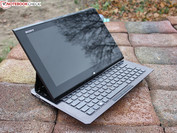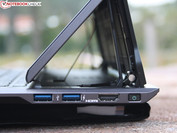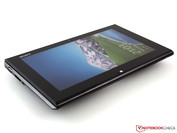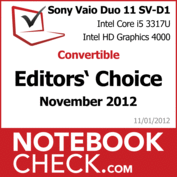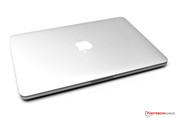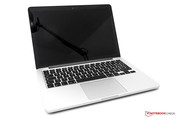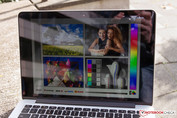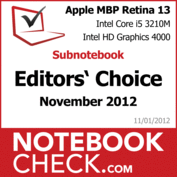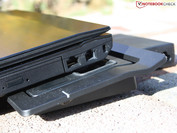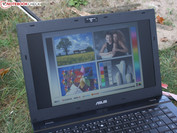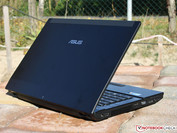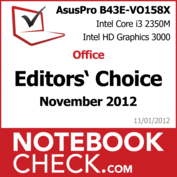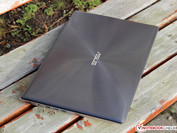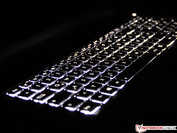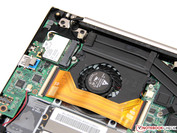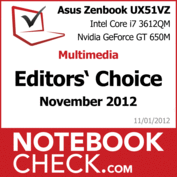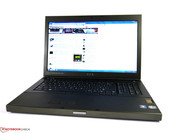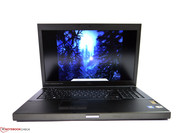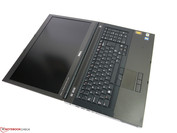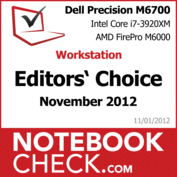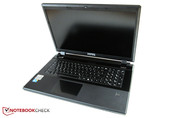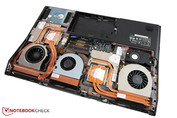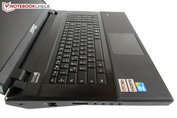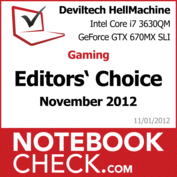Notebookcheck's Best of November 2012
For the original German review, see here.
Altogether six categories of reviewed laptops will be compared within their respective classes, with the end result that a segment winner will be determined for each of these for the month of November 2012. A new record has meanwhile been broken: 36 reviewed devices (only notebooks) passed through our test course - more than ever before.
The three Windows 8 convertibles, in addition to the Dell XPS 12 from October, make for three further partially unusual hybrid devices which mutate between being a subnotebook or a Windows tablet. Mechanically this is the easiest with the Taichi 21 from Asus. The software conversion is however a little more convoluted, and allows for new and in some cases optimized usability with a dual display.
In the case of the subnotebooks, Windows 8 meets multi-touchscreens. We were not especially impressed with the Asus VivoBooks however, although our expectations for the affordable entry-level touchscreen device for between 500 and 700 Euros (~$647 and $906) may have been set a little too high. The MBP Retina 13 rounded off Apple's Pro Series at the upper limit of the price range with its high-definition display. The display wasn't the only reason we rated the device with 90% though.
The office notebooks (x9) didn't stand out as much as in October (x14). Nevertheless, this class contained the best value for money devices along with some of the worst. Acer's E1 wasn't recommendable in many respects. The TravelMate P253 and the Vostro 2520 perform their work, but didn't manage to instill a satisfying office feeling though, unlike the Asus B43E or even the Nexoc B510. Many interfaces including TPM (Asus) and a docking port are available for a reasonable price.
While only two multimedia devices were up for review in October, November brought a further twelve laptops to the forefront. At the front of the pack the Asus "Ultrabook" UX51VZ stood its ground; A thin 15.6-inch notebook packing a GeForce GT 650M along with a quad-core CPU. The S56CM from the same manufacturer has opted for low-voltage (i5), as well as a dedicated GeForce GT 635M. Next to the commonly integrated mid-range hardware, Nexoc's M507II (Clevo W251EG) stood out with its GeForce GT 645M (Kepler, 28 nm). Using the native resolution, almost all games run smoothly.
The workstation onslaught which began in October, is now continued by a further three antagonists where the HP EliteBook 8570w and Fujitsu Celsius H720 left off. After the noisy rivals from Dell and HP, the Dell Precision M6700 stays extremely quiet even though it manages to achieve the highest performance rating (99%).
Category Convertible
Contenders:
Sony Vaio Duo 11 SV-D1121X9EB 87%
While we ended the month of October with the Dell XPS 12 convertible, November brought us the first competitor models available on the market with a tablet function. The Sony Vaio Duo 11 integrates the tablet with the use of a slidable joint. The manufacturing quality of the 11.6-inch device is very good, partially also due to the solid and thought through appearance of the mechanics. The ergonomic characteristics are excellent, and at the same time the application performance with an SSD and Core i5 are extremely good.
Somewhat more varied in terms of the operation is the Asus Taichi 21 with the same form factor. The foldable mini has a second display on the back of the display, which can be used as an extended desktop or as a presentation display. Big advantage: Two high contrast IPS panels, the inner one of which is matte (non-touch). The battery life with the integrated battery meanwhile lies just below that of the Vaio Duo 11 (3:15 versus 3:47 hours).
The Lenovo IdeaPad Yoga 13 (approximately 1300 to 1500 Euros/~$1683 to $1942) gets to its tablet mode via a different path. The foldable display can just be turned around by 360 degrees, whereby the keyboard is then behind it. As with the Dell XPS 12, the Sony Vaio Duo 11 and the Asus Taichi 21, Lenovo has also opted for a high contrast IPS 10 finger touchscreen (HD+ in this case instead of Full HD). Thanks to its high brightness a curtailed use in the sunshine is still possible despite its reflective screen. The real keyboard unfortunately only gives very meager feedback, which could prove to be quite a hindrance to more productive users. For those that find the 13-inch devices too cumbersome, the Yoga 11 with an Nvidia Tegra 3 and Windows RT should be quite interesting.
Convertible notebook of the month of November 2012: Sony Vaio Duo 11 SV-D1121X9EB
The Duo 11 is surely not the perfect all-round solution for everyone. Nevertheless the manufacturing quality, as well as the input devices where subnotebook users will immediately feel at home, made a convincing impression on us. The Stylus pen allows for precise as well as handwritten entry. Something that isn't provided by the competition: Good rear camera and an optional battery slice for doubling the battery life.
» The Sony Vaio Duo 11 SV-D1121X9EB is currently available from 1500 Euro on Amazon.com
What we liked
A mechanical system for the slide-open panel which is suitable for day-to-day use. In the slate or tablet format, users don't necessarily notice the separate base unit and display panel.
What we'd like to see
It should be brighter when on battery, closer to that available on mains power.
What surprises us
The slider conversion mechanism seems to be the best compromise for a convertible. A real Windows 8 (not an RT version for Intel Atom) device that benefits from the Ultrabook performance. Many users will get by with the Duo 11 as an all-round device, and will no longer require a separate tablet.
The competition
We also reviewed Dell's XPS 12 and Microsoft's Surface RT (Windows RT). Further additions available soon: Toshiba Satellite U920t, HP Envy X2, Acer Iconia W510P
Category Subnotebook
Contenders:
Apple MacBook Pro Retina 13-inch 2012-10 90%
Asus VivoBook S400CA-CA006H 85%
Asus VivoBook S200E-CT182H 82%
HP Envy 4-1000sg 79%
Medion Akoya S4216 MD 99080 78%
Lenovo ThinkPad X1 Carbon N3N34GE 87 %
Our editorial team wasn't sure about the 13-inch MacBook Pro (2049 Euros/~$2652) with a high-definition Retina display. Manufacturing quality and input devices meanwhile are up to the highest standard, while the connectivity features are of the lowest standard. The popular panel "only" received a rating of 83% in our opinion though, due to the visible bleeding with a dark background (illumination 75%). One thing that surprised us was the good battery life of the i5 3210M (6:48 hours). The stereo speakers with a decent audio quality are also better than usual for this form factor.
Closely behind follows the Lenovo ThinkPad X1 Carbon (1450 Euros/~$1877). The 14-inch panel may only have a resolution of 1600-x-900 pixels, but the connectivity features are somewhat better. The Carbon however doesn't have a docking port either; something that would have made for a perfect package for the ultra-thin, highly mobile device (6 hours WLAN test, bright display). Since the emissions are also low and the performance isn't hampered by throttling, this represents a well-rounded business package, which hardly has any weaknesses except for the connectivity. The TN panel provides good viewing angles, although it isn't able to keep up with the likes of IPS panel displays (ThinkPad X220).
Consumers will likely find the aforementioned subnotebooks too expensive, which is why they are likely to have a keen interest for Asus' new VivoBook Series with Windows 8. The 14-inch S400CA (750 Euros/~$971) has streamlined dimensions and has a very high quality appearance. Its specialty: Multi-touch display. The performance with its Core i5 and the hybrid hard drive (SSD cache) has been categorized as very good as is typical for Ultrabooks. A weakness is the low luminance of the display panel, which dims down to a subterranean 132 cd/m² when battery powered. Due to this the reflective display will likely not be of much use in sunny surroundings.
With the smaller VivoBook S200E (500 Euros/~$647) the picture looks a little different. The luminance falls to 164 cd/m² when battery powered, and the display is certainly also reflective. We like the all-aluminum chassis which almost comes close to the Zenbook quality, as well as the partially very good input devices. The low system noise is however achieved at the expense of substantial CPU throttling.
In case a 13-inch device with a touchscreen is the object of desire, then the Sony Vaio SV-T1312V1ES for 860 Euros (~$1113) is sure to fulfill the price expectations of some buyers. The configuration is certainly interesting, since there is still a RAM slot free for an upgrade along with the Core i5, 4 GBs of RAM and an mSATA 128 GB SSD. The very long battery life (5:50 hours) and the good manufacturing quality (including input devices) immediately make a good impression. One considerable weakness is the low contrast TN display panel though. Typing and swiping fingers across this turns out to be less fun than could have been hoped for.
In case an affordable Ultrabook is a more sought after candidate, then prices currently start at about 600 Euros (~$777). In most cases this entails Core i3 configurations, such as for example the HP Envy 4-1000sg (2367M) or the Medion Akoya S4216 (3217U), both of which have an SSD cache. Medion however almost manages to achieve true SSD speeds with this affordable device thanks to a clever RAID-0 combination. Unfortunately the Akoya is also hampered by its own fault: The chassis is unusually bendable, whereby the Envy 4 clearly excels in comparison, even if it isn't perfect either. As a small consolation the Medion also provides an additional battery for the multi-bay slot, which then replaces the integrated DVD drive; something which represents a novelty among Ultrabooks.
Subnotebook of the month of November 2012: Apple MacBook Pro Retina 13
Expensive but worth it. The high price is certainly a potential topic of contention, and the sparse connectivity even more so. Nevertheless, the MacBook Pro Retina 13 is an almost perfect companion, with a manufacturing quality that is unrivaled as yet. Business users should take a closer look at the Lenovo ThinkPad X1 Carbon though. This may not have a Retina, but is substantially cheaper to acquire.
» The Apple MacBook Pro Retina Display MC975D/A is currently available from 2020 Euros on Amazon.com
What we liked
The improved mobility in terms of a good battery runtime, a low overall weight, and a thin case. The fine resolution of the Retina display and the multimedia performance are also able to make a convincing impression.
What we'd like to see
A third USB port, the possibility to clean the cooling fan quickly, further BTO options, and a battery which is not permanently attached to the device.
What surprises us
The limited upgradability, which we are so far only familiar with from the slim MacBook Air. The countless adapters also don't make for very convenient travel accessories. Currently many applications are already HiDPI compatible, although there are still some exceptions. The new interface standard Thunderbolt doesn't seem to have established itself so far. Accessories are rare and relatively expensive.
The competition
From the Apple universe: The MacBook Pro 15 with a Retina display for heavy users or those needing higher performance; the normal and furthermore attainable MacBook Pro 13 mid 2012 for 500 Euros (~$647) less, or the thinner MacBook Air 13 mid 2012 with a ULV processor. With Windows: The Asus Zenbook Prime UX31A with Full HD display, the Samsung 900X3C-A04DE with a bright display, or the Acer Aspire S7 with a 12 millimeter (~0.47 inches) chassis.
Category Office
Contenders:
Bullman C-Klasse SRD i7 15HD 84%
Acer TravelMate P253-M-32324G50Mnks 81%
Nexoc B510 81%
Samsung Series 3 300E5C-A06DE 81%
Dell Vostro 2520 80%
Toshiba Satellite Pro C870-11R 80%
Acer Aspire E1-531-B9606G50Mnks 76%
With such a large price difference you’d think there would be a bigger difference in practice. Starting off with the AsusPro B43E (600 Euros/~$777) and finishing with the Dell Latitude E6430 (approximately 1900 Euros/~$2459) both 14-inch notebooks are fully equipped with interfaces, and led us to ascribe a rating of 88% and 80% respectively (in terms of the connectivity). Despite the enormous price difference between the AsusPro and the Latitude E-series, the overall scores are neck and neck at 84% and 87% respectively. Will the docking capable B43E soon outpace the EliteBooks and Latitudes? What both of the devices have in common is the high contrast TN display panel with an HD resolution. Dell however provides the better keyboard and a high quality look, along with slightly better battery runtimes and a faster Samsung SSD. But who will want to spend an extra 1300 Euros (~$1683) for such a marginal improvement?
The Nexoc B510 (1078 Euros/~$1395) also wants to compete in the elevated office segment. The concept: Affordable plastic chassis with correspondingly meager input devices, but a full spectrum of interfaces, including a docking port compatible with the docking station included with the reviewed device (optional, approximately 200 Euros/~$259). The performance is "state of the art" with the Samsung SSD 830 and a Core i5. The display panel (TN-LED, narrow viewing angles, no other display options available) and the manufacturing quality (dull plastic) unfortunately fail to live up to the strived for ambitions. Comprehensive configuration options (configuration tool) and good upgrade possibilities are advantages.
Bullman’s C-Klasse SRD i7 15HD (1240 Euros/~$1605) is specialized for building sites and factory workshops. The case is made out of an alloy with magnesium and aluminum (Mg-Al), and is very rigid and robust. The 15-inch notebook has a technologically dated Intel Core i7-640M and is very heavy and extremely clunky. Nevertheless, the bright display (620 cd/m² when mains powered) is suitable for use in extremely bright surroundings. The concept has its flaws though: Why are the interfaces open and not protected against dust and water? Why is the luminance curtailed when battery powered? Those who are asking themselves the same questions would be better served with the Dell Latitude E6430 ATG.
In cases when the piggy bank for mum's new laptop only contains 500 Euros (~$647), then the low-cost class will be of interest. At the forefront are the Dell Vostro 2520 and the Acer Aspire E1-531 for 300 and 330 Euros (~$388 and $427) respectively. The 15-inch notebooks may not have a Windows operating system, but the Pentium provides for an acceptable performance. Acer unfortunately scares off potential buyers with an unworthy rattling keyboard. The Vostro is better in this case, but lags in terms of the display brightness in comparison.
What about the Acer TravelMate P253-M (469 Euros/~$607) or the Toshiba Satellite Pro C870 (515 Euros/~$667)? Something that sounds like solid day-to-day equipment in both cases has a matte display, a sufficiently stable chassis and a good Core i3 performance. When it comes to the keyboard the wheat is however separated from the chaff: The rattling keys on the Satellite cannot be recommended by us. Positive aspects of both devices are the low heat dissipation and system noise.
Finally, little money is demanded by Samsung for its Series 3 300E5C (500 Euros/~$647). It has only a Core i3 along with an HD 3000 to carry out the processing in this case as well. Samsung stands out positively with a long battery life and low system noise. When it comes to the areas of manufacturing quality, input devices and the display however, the 15-inch notebook remains of a similarly low (but usable) standard as the aforementioned low-cost models.
Office notebook of the month of November 2012: AsusPro B43E
Victory for Asus despite its unimpressive rating (84%) when pit against the Dell Latitude E6430s (87%). This may stir up some controversy with Dell fans, but the Asus for 600 Euros (~$777), together with the docking station for 150 Euros (~$194), provides for a steal in terms of the value for money. Three TFT interface options, docking port, TPM, ExpressCard34, together with good input devices, a long battery life and pleasant ergonomics - this isn't provided by any of the other competitors. Disadvantage: Asus doesn't provide any higher resolution displays.
» The AsusPro B43E-VO158X is currently available from 635 Euros (price has increased) from Amazon.com
What we liked
The complete business package with many interfaces for 750 Euros (~$971, inc. docking station). Asus provides a docking capable device for a small price.
What we'd like to see
A keyboard with good feedback, like the one on the Lenovo ThinkPads, would have complimented the B43E very well. Unfortunately this way a (bearable) weakness remains.
What surprises us
Asus opts for a series of antiquated interfaces with the Powerstation II, which are however useful for business.
The competition
HP ProBook 6470b (800 Euros/~$1035), Lenovo ThinkPad Edge S430 (740 Euros/~$958), Lenovo ThinkPad L430 (670 Euros dock/~$867), HP ProBook 6475b (700 Euros/~$906), HP ProBook 6465b (745 Euros/~$964), Dell Vostro 3460 (650 Euros/~$841), Fujitsu Lifebook S752 (680 Euros/~$880).
Category Multimedia
Contenders:
Asus UX51VZ 86%
Wortmann Terra Mobile 1773Q 83%
HP ProBook 4740s (B0Y81EA) 82%
Nexoc M507II 80%
Medion Akoya P6815 (MD98059) 79%
Samsung Series 3 350V5C-S07DE 79%
The Asus Zenbook UX51VZ (U500VZ at the time) already drew attention to itself at the 2012 IFA: At last a mid-range GeForce GT 650M and a Core i7 quad-core in a thin case with the Zenbook look. How can this be kept cool with a height of 6 to 20 millimeters (~0.24 to 0.79 inches)? Even when it comes to the stability the UX51VZ is able to keep up with the 11.6 and 13-inch Zenbooks. The aluminum chassis made up of a top and bottom plate is very rigid. We took a wary look at the cooling system and discovered a (tolerable) weakness: The loudly rotating cooling fan doesn't prevent a restrained throttling of the CPU. When it comes to the display users will however once again become enamored: Matte IPS display panel with Full HD resolution and good brightness. Looking at the price hearts will start to sink again though: 1700 to 2000 Euros (~$2200 to $2589).
More affordable, but with a similarly powerful gaming performance, is where things stand with the Wortmann Terra Mobile 1773Q (1350 Euros/~$1747). Not considering the flaring of the cooling fan, Wortmann has comprised a coherent 17-inch package, which is able to score points with a Full HD display, good battery life and a decent processing performance. We are underlining the display rating of 89%: Matte panel with approximately 300 cd/m² and an exceptionally good contrast ratio of 903:1. However, the TN type display panel only provides moderately wide viewing angles.
Those unwilling to fork out for a gaming capable device for their granny should probably take a closer look at the HP ProBook 4740s (650 Euros/~$841). The 17-inch notebook offers several office qualities (matte, good input devices, day-to-day suitability) as well as gaming power for beginners (Radeon HD 7650M). This should usually suffice for medium details, and the grandmother will be delighted with the lush colors (good contrast) on the HD+ display. Biggest disadvantage in our opinion: The permanently audible cooling fan.
The Asus S56CM is somewhat better in this respect; even though it has a slightly more powerful graphics card on board (GeForce GT 635M). The 15-inch notebook is almost as thin as an Ultrabook, but nevertheless still possesses a DVD drive. Typical for an Ultrabook moreover is the Intel Core i5 3317U. The drawbacks however also accumulate: Reflective and colorless TN display panel with poor viewing angles, and a keyboard with meager feedback. These unfortunately overshadow the positive impact of the good cooling system and the corresponding absence of CPU throttling.
If only the Asus S56CM had the display used by the HP Envy dv6-7202eg. HP demands a hefty price (approximately 1200 Euros/~$1553) and only provides a GeForce GT 630M in exchange. In return the Full HD display is a real humdinger: 87% is what the matte, bright, high contrast display with wide viewing angles is worth to us. The quad-core fortunately aids the GPU in order to reach frame rates which allow for gaming with an HD resolution and high details.
More gaming power is provided by the Nexoc M507II with an Nvidia GeForce GT 645M and an Intel Core i7-3630QM. For 965 Euros (~$1249) customers however have to make due with a low contrast HD display, which is at least non-reflective though. On the other hand the Kepler GPU has hardly any difficulties with the highest details using the native resolution. Unfortunately gaming is accompanied by high temperature and noise emissions, and the manufacturing quality in only up to an average standard.
Gaming doesn't necessarily require 1000 Euros (~$1294) in all cases. At least according to Medion, who have equipped the Akoya P6815 (MD98059) with a GeForce GT 650M and an Intel 3610QM. The price is enticing: 700 Euros (~$906). Unfortunately, as is so often the case, a compromise has to be made. In this instance the manufacturing quality, the keyboard, and the less than ideal display. The unfavorable location of the interfaces and the slow hard drive are further points of criticism.
The Radeon HD 7670M is already available as a graphics solution with notebooks from 500 Euros (~$647). Accompanying processors tend to be a Pentium or Core i3 variant in most cases. The gaming performance hereby is often not the best, as we had to discover with the Sony Vaio SV-E1712F1EW (Intel Pentium B980, 550 Euros/~$712). Samsung combines the HD 7670M with an Intel Core i7-3610QM, and puts it all into the Series 3 350V5C (765 Euros/~$990). When it comes to the display panel though, the 15-inch notebook doesn't have anything to offer except for its non-reflective surface. The meager stability of the chassis may not impair the application performance, but the qualitative impression of the device is nevertheless hampered substantially.
A graphics card is too weak? Let's just take two then. At least this is what Lenovo has done with the IdeaPad Z585 (749 Euros/~$969). In this case a Radeon HD 7660G + HD 7670M stoke the fire with dual graphics, allowing for medium details with most games. The processing power of the AMD A10 quad-core is able to keep up with Intel's Core i5. Ergonomically the plastic chassis is not particularly good, but still as bearable as the sparse connectivity options. The TN display panel fails to impress due to the reflective surface and the low contrast.
If the gaming performance leaves a lot to be desired, then can we find at least the thin Ultrabook look? Samsung's Series 5 530U4C-S02 (769 Euros/~$995) combines affordable Ultrabook components and rounds them off with a GeForce GT 620M. The GPU isn't suitable for high-end games, but medium details should nevertheless still be a viable option in most cases. Using the integrated HD Graphics 3000 (Optimus graphics switching) performance such as this won't be achieved.
Last but not least we have two cheapskate configurations with gaming ambitions to look at. The Radeon HD 7650M (Sony Vaio SV-E1712F1EW, 550 Euros/~$712) and the GeForce GT 520MX (Samsung Series 3 300E7A, from 399 Euros/~$439) should allude to gaming suitability. In the case of the Vaio users can indeed indulge in the pleasures of gaming. In Samsung's case this promise remains unfulfilled: The Pentium doesn't impede the frame rates, but rather the weak GT 520MX. Otherwise the two 17-inch notebooks have office qualities on offer, whereby the Samsung receives a better rating thanks to its non-reflective display and the Silent Mode.
Multimedia notebook of the month of November 2012: Asus Zenbook UX51VZ (U500VZ)
Expensive but also (almost) perfect. The 15.6-inch notebook combines the wishes of demanding users into an extremely thin case. Despite quad-core and gaming power there is even a very good battery life of over five hours. In light of these points the ergonomic drawbacks will quickly be forgotten.
» The ASUS UX51VZ-CN035H ZENBOOK (i7 3612QM, 8 GB, 256 GB SSD, GT 650M is currently available from 1700 Euros at Notebooksbilliger.de
What we liked
Even though it is as thin and light as a comparably sized Ultrabook, the Zenbook offers the performance reserves of a full-fledged multimedia juggernaut. Also qualitatively the manufacturer provides everything that is good and expensive: The exemplary manufacturing quality of the aluminum case and the great input devices justify the considerable price.
What we'd like to see
There isn't really much to criticize about the UX51VZ - with the exception of two points: The system noise in an idle state could definitely be improved by Asus. Since the temperatures don't start to increase notably until the system is fully utilized, improvement should at least be possible from a thermal perspective. Otherwise the DisplayPort for especially large displays is also missing.
What surprises us
Even if the notebook isn't completely spared the processing impediment of throttling in extreme situations; it is still thoroughly astounding how well the cooling system handles the considerable heat dissipation of the graphics card and the processor. Although significantly thicker, the Dell XPS 15 has far more difficulties in this discipline.
The competition
The main rival of the UX51 is the somewhat higher quality, but outrageously expensive, MacBook Pro 15 Retina from Apple. Depending on the application area it would however also be possible to consider the Dell XPS 15, the Sony Vaio SV-S1511, or the extremely thin Samsung 900X4C with a ULV CPU as competitors.
Category Workstation/DTR
Contenders:
The 17-inch Dell Precision M6700 and Fujitsu Celsius H920 don't make a secret of their strengths. On the desktop the approximately four kilograms (~8.8 pounds) at least provide for a stable base, and should include enough copper to sufficiently cool the quad-cores. Cooling is best performed by the Precision, which is inaudible with a low processing load! Contrary to this the Fujitsu's hard drive alone (along with the Micron 256 GB SSD) is already clearly audible. AMD's FirePro M6000 (Dell) is more or less equal to the Nvidia Quadro K3000M (Fujitsu), or is significantly outperformed - depending on the CAD application. See our SPECviewperf 11 test in both reviews for details. The prices are certainly on an elevated level, with 3300 Euros (~$4271) for the H920 and 5200 Euros (~$6731) for the Precision M6700 representing the cost of our reviewed configurations. It is worth bearing in mind though that there are also more affordable configurations available.
Workstation panels are the best available on the market. For Dell's and Fujitsu's Full HD TN displays this is only partially true. Good contrast and sRGB color space are achieved, but the viewing angles are not Best-of-Class (IPS). The 14-inch EliteBook 8470w waves goodbye at this point with narrow viewing angles, missing sRGB color space coverage, and a low contrast. The HD+ display could also probably have found a home in a consumer notebook. The cool case, the perfect input devices and the workstation typical array of interfaces, do however make the 8470w a candidate when an affordable (1300 Euros/~$1683) and compact workstation is sought after (different configurations, simple model reviewed, AMD FirePro M2000).
Workstation of the month of November 2012: Dell Precision M6700
The Precision M6700 has it easy. Fujitsu’s Celsius H920 may technically be similarly potent, but in terms of ergonomics and quality of the materials, the Dell workstation takes the lead. The RGB-LED Full HD IPS display panel sets the standard in its class in terms of the color space, contrast, brightness and viewing angles. This could be expected for a price of 5000 Euros (~$6472) though. The H920 and EliteBook 8470w aren't able to keep up in this discipline, but also cost substantially less.
What we liked
That even a workstation can be quiet with a low processing load, and nevertheless still has a potent performance when necessary.
What we'd like to see
Well developed drivers for AMDs FirePro M6000 and a somewhat more moderate pricing.
What surprises us
That the driver update for AMDs FirePro irons out some problems, but in exchange primarily leads to a noticeable reduced performance in the CAD area of all things.
The competition
Dell Precision M4700, HP EliteBook 8570w, HP EliteBook 8770w, Fujitsu Celsius H720, Fujitsu Celsius H920, Lenovo ThinkPad W530, Clevo Barebones with Quadro graphics cards.
Category Gaming
Contenders:
Deviltech HellMachine 85%
Deviltech and Schenker let all hell break loose. The 17-inch HellMachine and the XMG U702 are based on different Clevo Barebones. Both are nevertheless able to harbor and cool Nvidia's SLI behemoths GeForce GTX 670MX SLI and GTX 680M SLI. The HellMachine fares better in this case. The case remains very cool, but unfortunately at the expense of peace and quiet. The XMG U702 stumbles in this instance with noticeably more noise and a warmer chassis. The gaming performance is second to none with both devices, something that is of course also valid for gaming with the native Full HD. The matte display panel of the HellMachine trumps the reflective XMG U702 display. Although the XMG may be able to cover the AdobeRGB color space, the contrast and brightness are somewhat lower. In return the XMG also has even better viewing angles though.
Gaming notebook of the month of November 2012: Deviltech HellMachine
Schenker loses important points due to its extremely short battery life (very high power consumption), the enormously loud cooling system, and the cumbersome use of two AC adapters. The better GAMUT display panel and the improved performance of the desktop GPU and GTX 680M SLI doesn’t pay off as a result when it comes to the bottom line. The Deviltech HellMachine nonetheless still remains a notebook, despite its heavy weight of 4.1 kilograms (~9.0 pounds/a good two hours of WLAN battery life). For a price of 1600 Euros (~$2071) Deviltech has the best offer. Schenker only provides the XMG U702 with a desktop CPU.




